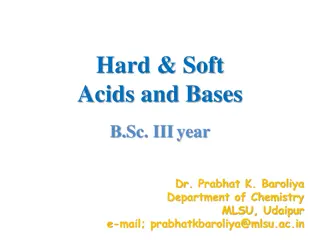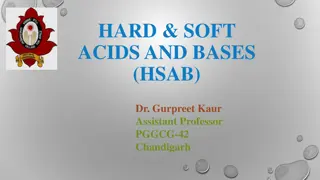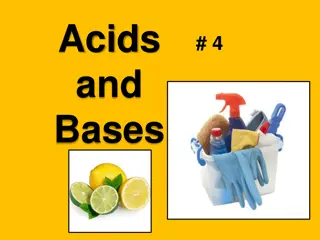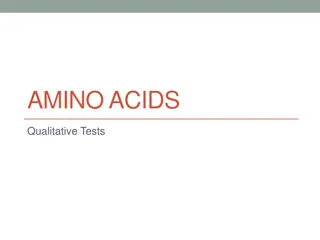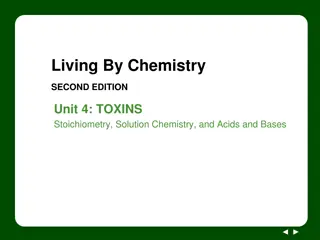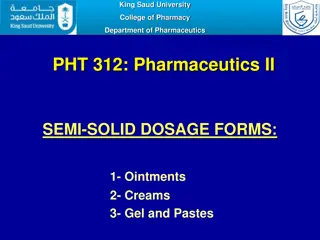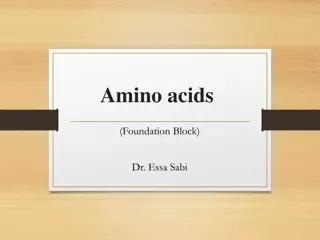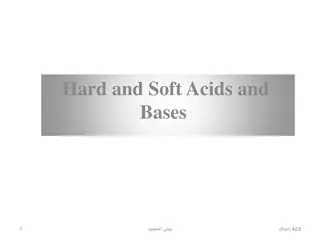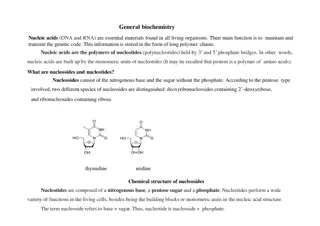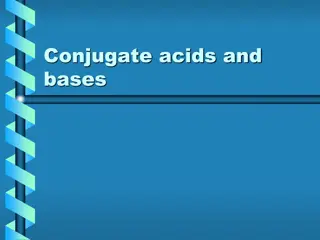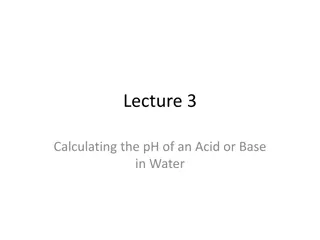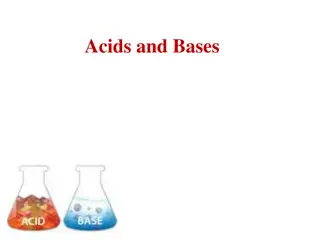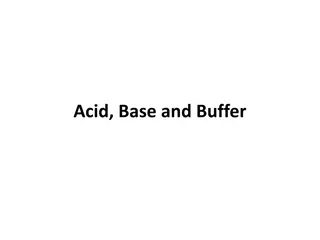Understanding Acids and Bases: A Comprehensive Overview
Learn about the fundamental concepts of acids and bases, their classifications, and key theories by Arrhenius and Brønsted-Lowry. Explore the importance of pH balance in living organisms and how different substances exhibit acidic or basic properties through informative visuals.
Download Presentation

Please find below an Image/Link to download the presentation.
The content on the website is provided AS IS for your information and personal use only. It may not be sold, licensed, or shared on other websites without obtaining consent from the author. Download presentation by click this link. If you encounter any issues during the download, it is possible that the publisher has removed the file from their server.
E N D
Presentation Transcript
Introduction Living organisms are sensitive to the acidity of aqueous solutions in their internal and external environments. The pH of human blood must be kept at 7.4. An increase or decrease of only 0.2 pH units could mean death 3
Acids and Bases The definition of acid and base has changed over course of time. Acids and bases are substances with specific physical and chemical properties We can determine if substances are acidic or basic by testing their pH or by indicators. 4
Some classifications of acids and bases 1. Arrhenius acids and bases. 2. Bronsted-Lowry acids and bases. 3. Lewis acids and base. 5
Arrhenius's acid and base In 1884, Arrhenius defined that an acid is a substance that gives H+ and a base one that gives OH- . Namely, if an acid is HA and a base BOH, then HA H+ + A- and BOH B+ + OH- Svante Arrhenius (1859 1927) Acids and bases are electrolytes that form aqueous solutions with unique properties. 6
Arrhenius, a Swedish chemist, was the first to characterize acids and bases in terms of their chemical properties. According to Arrhenius, acids are solutes that produce hydrogen ions , H+(aq), in aqueous solutions, while bases produce hydroxide ions, OH-(aq), when dissolved in water. This model fails to satisfactorily account for the basic properties of compounds that do not contain the hydroxide ion, such as ammonia (NH3(aq)). 7
Brnsted-Lowry's acid and base In 1923, Johannes Br nsted of Denmark and Thomas Lowry of England recognized that, in most acid base interactions, a proton (H+ ion) is transferred from one reactant to another. J. Br nsted (1879 1947) T. Lowry (1874 1936) 8
According to Brnsted and Lowry, when hydrogen chloride reacts with water, a proton is transferred from a hydrogen chloride molecule to a water molecule, forming a hydronium ion and a chloride ion. Hydrogen chloride acts as a Br nsted Lowry acid; water acts as a Br nsted Lowry base. Notice the single arrow in the equation, indicating that hydrogen chloride is a strong acid, ionizing quantitatively (completely) when it reacts with water. 9
When ammonia reacts with water, a water molecule acts as a Br nsted Lowry acid, donating a proton to ammonia, the Br nsted Lowry base. Notice the double arrow in the equation, indicating that ammonia is a weak base, ionizing incompletely and forming a dynamic equilibrium with the products of the reaction. 11
Water can behave as base : Amphoteric (Amphiprotic): in the Br nsted Lowry model, a substance capable of acting as an acid or a base in different chemical reactions; a substance that may donate or accept a proton. 12
According to the BrnstedLowry concept, acid base reactions involve the transfer of a proton. These reactions are universally reversible and result in an acid base equilibrium. H:A + B: Acid1 base2 conjugate conjugate Acid2 Base1 B:H+ + A- (conjugate acid-base pairs are HA-A- and B:H+-B:) 13
A conjugate acidbase pair consists of two substances that differ only by a proton the acid has one more proton than its conjugate base. A strong acid has a very weak attraction for protons. A strong base has a very strong attraction for protons. The stronger an acid, the weaker its conjugate base, and conversely, the weaker an acid, the stronger its conjugate base. 14
Properties of acids 1. pH values lower than the neutral value of 7. 2. Sharp sour Taste. 3. React with certain metals to liberate hydrogen gas. 4. Soluble in water release H+ ions in solution. 5. Are often corrosive. 6. Strong acids can damage the skin and be dangerous. 7. Are neutralized bases. 8. They react with carbonates and bicarbonates to give off carbon dioxide gas. 9. React with active metals to release hydrogen gas 15
The strength of an acid depends on the concentration of H+ ions formed in solution. Strong acids produce a high concentration of H+ ions whereas weak acids produce a low H+ concentration in solution. one H in a molecule that can form hydrogen ions is called a monoprotic acid, e.g. H+ Cl- A diprotic acid will give two H+, e.g. H2SO4. An example of a triprotic acid is phosphoric acid, H3PO4. Which one of them is stronger? 16
Strong acids ionize completely when in solution, e.g. sulphuric acid. Weak acids do not ionize completely when in solution, e.g. ethanoic acid 17
Dissociation depends on: Temperature. (Temp.) Concentration. (conc.) Nature of solution. (solut.) 18
Lewis acids and bases Lewis acid that accepts lone pair electrons. A is defined to be any species A Lewis base is any species that donates lone pair electrons. 19
Some common reactions to all acids Dilute acids react with reactive metals to release hydrogen gas and form a salt. Dilute acids react with metal carbonates and to form a salt, carbon dioxide and water. 21
Dilute acids react with metal oxides to form a salt and water. Dilute acids react with alkalis to form a salt and water. This is called a neutralization reaction. 22
A base is a substance that reacts with an acid to produce a salt and water only. An alkali is a solution of a base in water. Just as there are weak and strong acids, there are weak and strong alkalis. The strength of an alkali depends on the amount of OH- ions in solution. The more an alkali ionizes the stronger it is. 24
Properties of bases: 1. The pH of the solution lies between 8 and 14. 2. Soluble bases are called alkalis, e.g. sodium hydroxide, NaOH , potassium hydroxide, KOH, and ammonium hydroxide, NH4OH. 3. Bases are oxides or hydroxides of metallic elements. 4. Bases and alkalis will react with acids to neutralize them, forming salts plus water: 26
5. All alkalis contain a hydroxide ion, OH-, that will react with and pickup a H+ ion to form a water molecule. 6. Bitter taste. 7. Soapy feeling when in a solution. 8. Restore blue color to litmus that was turned red by an acid. 27
Bases Containing Nitrogen These are best called nitrogenousbases , which is a term often used in relation to amines, amino acids and proteins. Bases referred to in medicine and biology usually contain nitrogen atoms that have the ability to pick up a proton and become a positive ion: 28
Salts 29
a salt is any ionic compound composed of positively charged cations and negatively charged anions, so that the product is neutral and without a net charge. These ions can be inorganic (Cl ) as well as organic (CH3COO ) and monoatomic (F ) as well as polyatomic ions (SO42 ). Salts are formed (as well as water) when acids and bases react. 30
Salts can be prepared by: 1. Synthesis (or direct combination of elements) e.g.: 31
2. The action of an acid on (i) a metal, (ii) an insoluble metal oxide, carbonate, (iii) an alkali or soluble carbonate. hydroxide, or 32
Thank you 34



